Solar eclipse of January 11, 1842
A annular solar eclipse occurred on January 11, 1842 during summer. A solar eclipse occurs when the Moon passes between Earth and the Sun, thereby totally or partly obscuring the image of the Sun for a viewer on Earth. An annular solar eclipse occurs when the Moon's apparent diameter is smaller than the Sun's, blocking most of the Sun's light and causing the Sun to look like an annulus (ring). An annular eclipse appears as a partial eclipse over a region of the Earth thousands of kilometres wide.
| Solar eclipse of January 11, 1842 | |
|---|---|
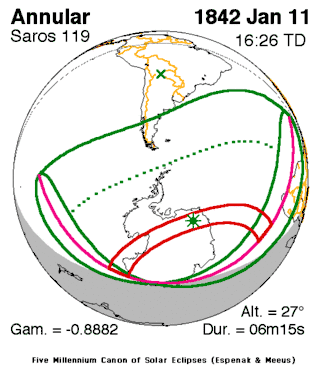 Map | |
| Type of eclipse | |
| Nature | Annular |
| Gamma | -0.8882 |
| Magnitude | 0.9151 |
| Maximum eclipse | |
| Duration | 375 sec (6 m 15 s) |
| Coordinates | 75.8°S 1.4°E |
| Max. width of band | 710 km (440 mi) |
| Times (UTC) | |
| Greatest eclipse | 16:25:41 |
| References | |
| Saros | 119 (56 of 71) |
| Catalog # (SE5000) | 9144 |
It was the first of three solar eclipses that took place that year, the next was a total eclipse on July 8, 1842 and covered almost all of the Northern Hemisphere.[1] It was the solar saros 119 cycle of eclipses[2]
Description
The eclipse was visible in much of the three southern oceans including the southeast part of the Pacific, most of the South Atlantic Ocean and its islands and small parts of the Indian Ocean surrounding Antarctica with a tiny bit probably excluded. It also included the southern tip of South America which included Patagonia and the Falkland Islands and the Cape Colony (now Southern and Northern Cape which are part of South Africa).
It showed 30% obscuration at Ushuaia and the Falklands (or Malvinas), 50% around the South Georgia, South Orkney and Livingston Islands, 60% at the north of the Antarctic Peninsula and 80% in the middle part.
The rim of the eclipse included southeast of Tuamotu Islands, Puerto Montt and areas south of Buenos Aires.
The eclipse started at sunrise offshore from New Zealand and ended at sunset in a smaller part of southern Africa. The greatest eclipse was in midcentral Antarctica at 75.8 S and 1.4 E some kilometers from the Prime Meridian at 16:25 UTC[1] The duration was 6 min 15 seconds and showed 91.5% obscuration of the sun.
Related eclipses
Saros 119
It is a part of Saros cycle 119, repeating every 18 years, 11 days, containing 71 events. The series started with partial solar eclipse on May 15, 850 AD. It contains total eclipses on August 9, 994 AD and August 20, 1012 with a hybrid eclipse on August 31, 1030. It has annular eclipses from September 10, 1048 through March 18, 1950. The series ends at member 71 as a partial eclipse on June 24, 2112. The longest duration of totality was only 32 seconds on August 20, 1012. The longest duration of annularity was 7 minutes, 37 seconds on September 1, 1625. The longest duration of hybridity was only 18 seconds on August 31, 1030.
| Series members 54–70 occur between 1801 and 2100: | ||
|---|---|---|
| 54 | 55 | 56 |
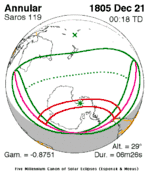 December 21, 1805 |
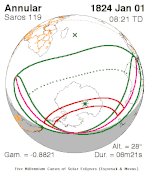 January 1, 1824 |
 January 11, 1842 |
| 57 | 58 | 59 |
 January 23, 1860 |
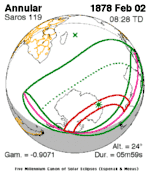 February 2, 1878 |
February 13, 1896 |
| 60 | 61 | 62 |
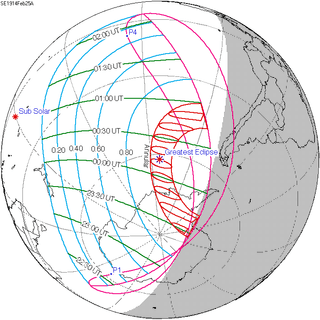 February 25, 1914 |
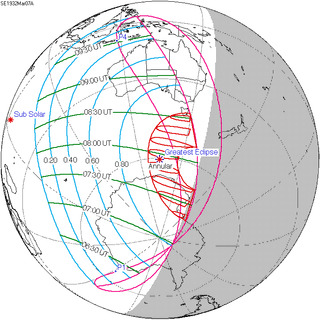 March 7, 1932 |
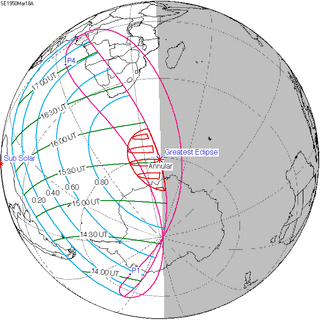 March 18, 1950 |
| 63 | 64 | 65 |
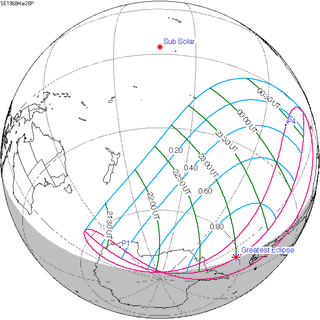 March 28, 1968 |
 April 9, 1986 |
 April 19, 2004 |
| 66 | 67 | 68 |
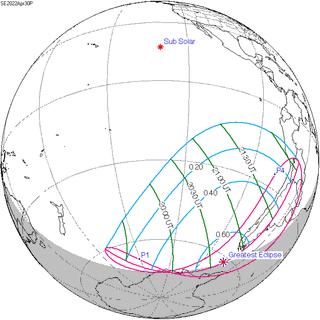 April 30, 2022 |
 May 11, 2040 |
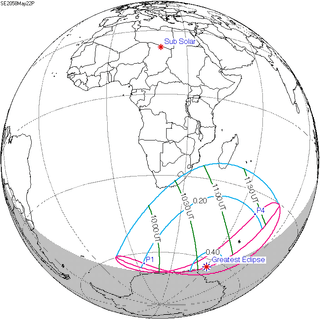 May 22, 2058 |
| 69 | 70 | |
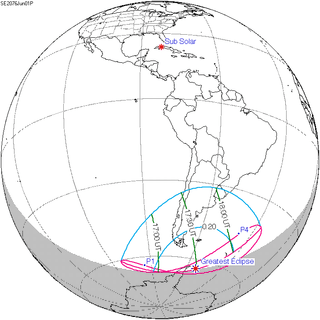 June 1, 2076 |
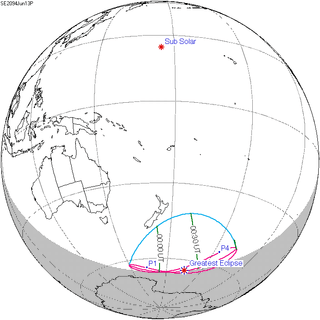 June 13, 2094 | |
See also
- List of solar eclipses in the 19th century
- List of solar eclipses visible from Antarctica
References
- "Solar eclipse of January 11, 1842". NASA. Retrieved March 14, 2017.
- "Solar Saros 119". NASA. Retrieved March 14, 2017.
.jpg)
